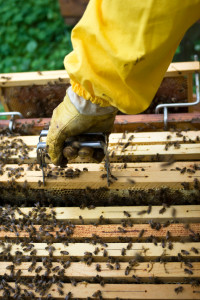Rest easy, Austin. Pest control measures and saving bees from impending doom can coexist.
 Reports vary, but Colony Collapse Disorder kills between 30% and 90% of our bee population each year. The Department of Agriculture and the Environmental Protection Agency recognize CCD as a serious concern, yet conflicting information results in public mass confusion. Pest control chemicals can affect bees when applied carelessly, but Austin residents can both live without pests and save the bees.
Reports vary, but Colony Collapse Disorder kills between 30% and 90% of our bee population each year. The Department of Agriculture and the Environmental Protection Agency recognize CCD as a serious concern, yet conflicting information results in public mass confusion. Pest control chemicals can affect bees when applied carelessly, but Austin residents can both live without pests and save the bees.
What is CCD?
Worker bees, those industrious workers that collect nectar, fly off to work and don’t return. They die away from the hive, which leaves the queen and young bees alone. Queens and baby bees can’t maintain the colony and the entire colony collapses. This is CCD, and it’s often mistaken for pesticide poisoning, which has a definitive cause resulting in many dead bees in and around the hive.
USDA and EPA researchers have strong leads regarding the cause of CCD, but they can’t yet point fingers at the exact culprit. Currently, researchers narrowed CCD’s likely cause to four focal points.
Pathogens: These nasty biological agents destroy bees’ health.
Parasites: Bees in many collapsed hives have been struck down by Varroa mites.
Management Stressors: Long-distance transportation of hives, crowded hives and poor nutrition may contribute to CCD.
Environment: Pesticide methods of pest control, contaminated water and low supplies of pollen and nectar could be CCD factors.
Since 33 % of the food on our plates requires bee pollination, researchers have more than enough motivation to find the cause of CCD.
Save Bees from Impending Doom
Everyone in and around Austin can save bees from CCD, and it doesn’t take heroic measures to keep the honey pot full.
Create a garden with bee-friendly plants that grow well in Texas. Plant a large assortment to give bees the diverse nectar they require. Bee-friendly plants include bee bush, common yarrow, larkspur, persimmons and Texas betony.
Become a backyard beekeeper. Beekeeping isn’t time consuming or difficult, and CCD has prompted many hobbyists and honey enthusiasts to host hives in their yards. You can get information on beekeeping and local colony sources from any beekeeping group, society or club.
Support local beekeepers and their efforts to resuscitate the bee population by buying local honey.
If bee colonies establish homes where they aren’t welcome, transplant them. Bee removal specialists can move a colony intact to a new location.
Exercise caution with pesticides. Avoid products labeled as harmful to bees and don’t use pesticides in the middle of the day when bees are active.
Ridding your home of unwanted pests needn’t compromise bees or food dependent upon pollination. If you have a specific question regarding our pest control practices and bee safety, or if you have an unwanted colony you need transported to our Austin apiary, contact us to schedule service. Our partiality for honey fuels our desire to spare bees from impending doom.